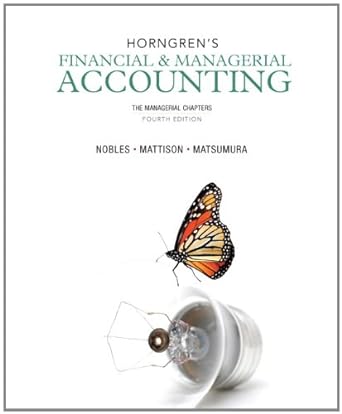Question
Garrett Company has the following transactions during the months of April and May: Date Transaction Units Cost/Unit April 1 Balance 500 17 Purchase 200 $5.40
Garrett Company has the following transactions during the months of April and May:
| Date | Transaction | Units | Cost/Unit |
| April 1 | Balance | 500 | |
| 17 | Purchase | 200 | $5.40 |
| 25 | Sale | 150 | |
| 28 | Purchase | 100 | 5.80 |
| May 5 | Purchase | 250 | 5.40 |
| 18 | Sale | 300 | |
| 22 | Sale | 50 | |
The cost of the inventory on April 1 is $5, $4, and $2 per unit, respectively, under the FIFO, average, and LIFO cost flow assumptions.
Required:
1. Compute the inventories at the end of each month and the cost of goods sold for each month for the following alternatives:
- FIFO periodic
Cost of Goods Sold Ending Inventory April $ fill in the blank 1 $ fill in the blank 2 May $ fill in the blank 3 $ fill in the blank 4 - FIFO perpetual
Cost of Goods Sold Ending Inventory April $ fill in the blank 5 $ fill in the blank 6 May $ fill in the blank 7 $ fill in the blank 8 - LIFO periodic
Cost of Goods Sold Ending Inventory April $ fill in the blank 9 $ fill in the blank 10 May $ fill in the blank 11 $ fill in the blank 12 - LIFO perpetual (Round your intermediate calculations to the nearest cent.)
Cost of Goods Sold Ending Inventory April $ fill in the blank 13 $ fill in the blank 14 May $ fill in the blank 15 $ fill in the blank 16 - Weighted average (Round unit costs to 4 decimal places and final answers to the nearest dollar.)
Cost of Goods Sold Ending Inventory April $ fill in the blank 17 $ fill in the blank 18 May $ fill in the blank 19 $ fill in the blank 20 - Moving average (Round unit costs to 2 decimal places and final answers to nearest dollar.)
Cost of Goods Sold Ending Inventory April $ fill in the blank 21 $ fill in the blank 22 May $ fill in the blank 23 $ fill in the blank 24 2. Reconcile the difference between the LIFO periodic and the LIFO perpetual results. If an amount is zero, enter "0". April Cost of Goods Sold Ending Inventory Difference $ fill in the blank 25 $ fill in the blank 26 May Cost of Goods Sold Ending Inventory Difference $ fill in the blank 27 $ fill in the blank 28
3. If Garrett uses IFRS, which of the previous alternatives would be acceptable, and why?If Garrett Company uses IFRS, it may report its inventory under FIFO . It may not use Average under IFRS because it is not consistent with any presumed physical flow of inventory. Also, FIFO is not allowed for tax purposes in most other countries, so there is no tax incentive for a company to use Average . Note that companies that use IFRS and have rising inventory costs will report a higher income because they include holding gains in income.
- Moving average (Round unit costs to 2 decimal places and final answers to nearest dollar.)
- Weighted average (Round unit costs to 4 decimal places and final answers to the nearest dollar.)
- LIFO perpetual (Round your intermediate calculations to the nearest cent.)
- LIFO periodic
- FIFO perpetual
Step by Step Solution
There are 3 Steps involved in it
Step: 1

Get Instant Access to Expert-Tailored Solutions
See step-by-step solutions with expert insights and AI powered tools for academic success
Step: 2

Step: 3

Ace Your Homework with AI
Get the answers you need in no time with our AI-driven, step-by-step assistance
Get Started


